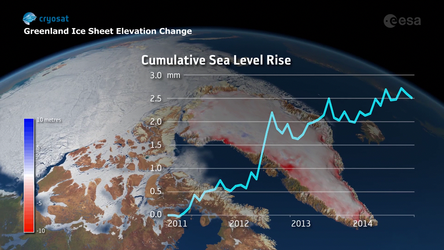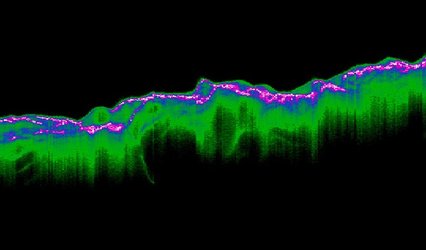Arctic freeze slows down
ESA’s CryoSat satellite has found that the Arctic has one of the lowest volumes of sea ice of any November, matching record lows in 2011 and 2012. Early winter growth of ice in the Arctic has been about 10% lower than usual.
CryoSat carries a radar altimeter that can measure the surface height variation of ice in fine detail, allowing scientists to record changes in its volume with unprecedented accuracy.
These observations are vital for tracking climate change and are an essential resource for maritime operators who increasingly navigate the icy waters of Earth’s polar regions.
The US National Snow and Ice Data Centre reported that the area of the Arctic covered by sea ice fell to 4.1 million sq km in September this year – slightly less than the sea-ice extent in September 2011.
But CryoSat shows that the ice was thicker at the end of summer than in most other years, at 116 cm on average. This means there was substantially more ice this year than in 2011.
Thicker ice can occur if melting is lower, or if snowfall or ice compaction is higher.
However, the Arctic usually gains about 161 cubic km of ice per day in November, but this year’s growth has been about 10% lower, at 139 cubic km per day, with a total ice volume estimated to have accumulated to 10 500 cubic km by the end of the month.
This would essentially tie with conditions in the Novembers of 2011, when levels were at their lowest on record for this time of the year.
Although sea ice in the central Arctic is currently thicker than it was in 2011, there is far less ice in more southerly regions such as the Beaufort, East Siberian and Kara Seas.

“Because CryoSat can measure Arctic sea ice thickness in autumn, it gives us a much clearer picture of how it has fared during summer,” said Rachel Tilling, at the UK’s Centre for Polar Observation and Modelling (CPOM), who came to these conclusions.
“Although sea ice usually grows rapidly after the minimum extent each September, this year’s growth has been far slower than we’d expect – probably because this winter has been warmer than usual in the Arctic.”
As demand for information on Arctic conditions increases, CryoSat has become an essential source of information for polar stakeholders, ranging from ice forecasting services to scientists studying the effects of climate change.
“In its short, six years of life, we have learnt more about Arctic sea ice from CryoSat than from any other satellite mission,” commented CPOM Director and principal scientific advisor to the CryoSat mission, Professor Andrew Shepherd.
“To understand the role that sea ice plays in the climate system, and the restrictions it places on maritime operations, we must ensure that its measurements are continued into the future.”
CPOM plans to release a complete assessment of 2016 sea ice conditions in the coming weeks.















 Germany
Germany
 Austria
Austria
 Belgium
Belgium
 Denmark
Denmark
 Spain
Spain
 Estonia
Estonia
 Finland
Finland
 France
France
 Greece
Greece
 Hungary
Hungary
 Ireland
Ireland
 Italy
Italy
 Luxembourg
Luxembourg
 Norway
Norway
 The Netherlands
The Netherlands
 Poland
Poland
 Portugal
Portugal
 Czechia
Czechia
 Romania
Romania
 United Kingdom
United Kingdom
 Slovenia
Slovenia
 Sweden
Sweden
 Switzerland
Switzerland































